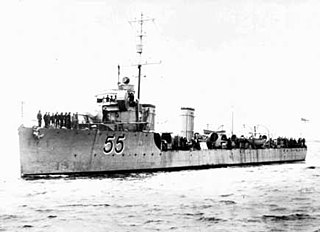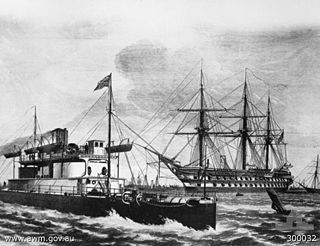
HMVS Cerberus is a breastwork monitor that served in the Victoria Naval Forces, the Commonwealth Naval Forces (CNF), and the Royal Australian Navy (RAN) between 1871 and 1924.

HMAS Parramatta, named after the Parramatta River, was a River-class torpedo-boat destroyer of the Royal Australian Navy (RAN). Ordered in 1909 for the Commonwealth Naval Forces, Parramatta was the first ship launched for the RAN. Temporarily commissioned into the Royal Navy for the delivery voyage to Australia, the destroyer came under Australian naval control in 1910, and was recommissioned into the RAN on 1 March 1911, shortly before the latter's formal creation.

The Erebus class of warships was a class of 20th century Royal Navy monitors armed with a main battery of two 15-inch /42 Mk 1 guns in a single turret. It consisted of two vessels, Erebus and Terror, named after the two ships lost in the Franklin Expedition. Both were launched in 1916 and saw active service in World War I off the Belgian coast. After being placed in reserve between the wars, they served in World War II, with Terror being lost in 1941 and Erebus surviving to be scrapped in 1946.

Before Federation in 1901 five of the six separate colonies maintained their own naval forces for defence. The colonial navies were supported by the ships of the Royal Navy's Australian Station which was established in 1859. The separate colonies maintained control over their respective navies until 1 March 1901, when the Commonwealth Naval Forces was created.

HMS Spiteful was a Spiteful-class torpedo boat destroyer built at Jarrow, England, by Palmers Shipbuilding and Iron Company for the Royal Navy and launched in 1899. Specified to be able to steam at 30 knots, she spent her entire career serving in the seas around the British Isles.

HMQS Paluma was a flat-iron gunboat operated by the Queensland Maritime Defence Force and later the Royal Australian Navy. She entered service on 28 October 1884, was decommissioned in 1916 and then sold to the Victorian Ports and Harbours Department, who operated her under the name Rip until 1948 when she was retired. She was scrapped in 1950–51.

HMQS Mosquito was a torpedo boat operated by the Queensland Maritime Defence Force and Commonwealth Naval Forces. She entered service in 1885 and after Federation was transferred to the Commonwealth Naval Forces, serving as a training vessel until she was paid off in 1910.
HMS Boxer was an Ardent-class destroyer which served with the Royal Navy, launched on 28 November 1894. She spent several years operating with the Mediterranean Fleet and remained active during the First World War. She was sunk in a collision on 8 February 1918.
HMS Hardy was a Hardy-class destroyer which served with the Royal Navy. She was built by William Doxford & Sons in 1895, launched on 16 December 1895, and sold off on 11 July 1911.
HMS Fervent was a Fervent-class destroyer which served with the Royal Navy. Fervent was launched on 28 March 1895 at Paisley.

HMS Zephyr was one of two Fervent-class destroyers which served with the Royal Navy. She was launched on 10 May 1895 from Hanna, Donald & Wilson at Paisley, Scotland. She served in home waters, and was sold in 1920.

HMQS Otter was launched in 1884 and served as a patrol vessel that served with the Queensland Maritime Defence Force and Commonwealth Naval Forces. She was paid off and sold in 1906, but the Royal Australian Navy requisitioned her in both world wars.

HMQS Midge was a torpedo launch that served with the Queensland Maritime Defence Force, the Commonwealth Naval Forces and the Royal Australian Navy. After entering service in 1887, Midge served as "picquet boat" along the Brisbane River until Federation in 1901, when she was transferred to the Commonwealth. After this, she served as a training boat until 1912 when she was decommissioned.

HMVS Childers was a torpedo boat of the Victorian Naval Forces, Commonwealth Naval Forces and the Royal Australian Navy.

The colonial service Acheron-class torpedo boats were built by the Atlas Engineering Company at Sydney in 1879 for the New South Wales naval service. They were originally armed with a single spar torpedo, but this was replaced in 1887 with two 14-inch torpedoes. They were sold in 1902.

HNoMS Storm was a 1.-class torpedo boat constructed in 1898. Storm served the Royal Norwegian Navy for almost 42 years, including neutrality protection duties during the First World War. She was lost in the 1940 Norwegian campaign of the Second World War. During the Norwegian Campaign, she was the only Norwegian warship that launched a torpedo against the invading Germans.

HMS Tiger was a torpedo boat destroyer of the Royal Navy. Built by John Brown on Clydebank as a three funnel 30-knot destroyer on speculation she was purchased by the Royal Navy under the 1899 – 1900 Naval Estimates.

Vesuvio was a protected cruiser of the Italian Regia Marina built in the 1880s. She was the third member of the Etna class, which included three sister ships. Named for the volcano Mount Vesuvius, the ship's keel was laid down in July 1883. She was launched in March 1886 and was commissioned into the fleet in March 1888. She was armed with a main battery of two 254 mm (10 in) and a secondary battery of six 152 mm (6 in) guns, and could steam at a speed of around 17 knots. Her career was relatively uneventful; the only significant action in which she took part was the campaign against the Boxer Uprising in China in 1900. She was stricken from the naval register in May 1911 and sold for scrap in 1915.
HMS TB 11 was a Cricket-class coastal destroyer or torpedo-boat of the British Royal Navy. TB 11 was built by the shipbuilder Yarrow from 1905 to 1907. She was used for local patrol duties in the First World War and was sunk by a German mine in the North Sea on 7 March 1916.














